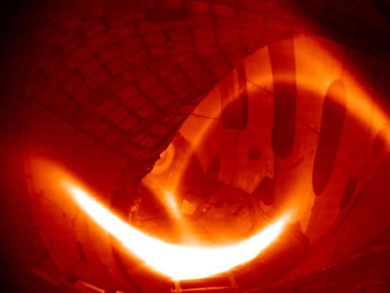The goal of fusion reactors is to produce energy from the fusion of atomic nuclei. However, because nuclear fusion ignites only at over 100 million degrees, no material can withstand this heat. Therefore, a hot hydrogen plasma is enclosed in a cage made of strong magnetic fields. For fusion reactors, two different constructions of the magnetic cage have prevailed: the tokamak and the stellarator.
The world’s largest fusion device of the stellarator type is the Wendelstein 7-X of the Max Planck Institute of Plasma Physics (IPP) in Greifswald, Germany. The centerpiece of the Wendelstein 7-X forms a ring of 50 superconducting magnet coils, each approx 3.5 m high. These coils are threaded onto a steel plasma vessel and surrounded by an annular steel sleeve. Cooled to near absolute zero by liquid helium, the magnetic coils generate a complex, spiral-contained magnetic field – the stellarator.
On 10 December 2015, helium plasma was already produced here as a precursor to the regular operation. On February 3, 2016, the fusion reactor entered its operating and experimental phase with the generation of the first hydrogen plasma. From March on, further stepwise extensions are planned to enable higher temperatures and longer plasma discharges.
In about four years, the Wendelstein 7-X should generate 30 minutes long discharges. They are considered the essential feature of stellarators. Tokomak plants can so far only produce short plasma pulses. At full heating capacity of 20 megawatts, the physicists want to check if a stellarator is suitable as a fusion power plant.
- Max-Planck-Institut für Plasmaphysik (IPP), Greifswald, Germany


